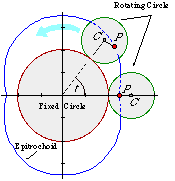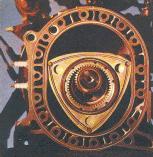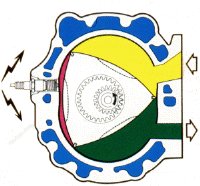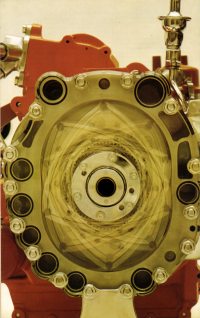How It Works
Though still considered to use the Otto cycle - in that it has intake, compression, power and exhaust "strokes" - the Wankel rotary engine bears little resemblance to the engines in most cars today. A typical engine uses narrow cylinders with pistons traveling up and down inside them, and then has to convert this linear motion into rotational motion through a crankshaft. Wankel�s engine, on the other hand, uses a triangular rotor instead of a piston, which rotates around an epitrochoidal cylinder.
 |
| An Epitrochoid |
An epitrochoid is a shape formed geometrically by taking a large central circle, placing a smaller circle on the outside of it, choosing any point within that smaller circle and then tracing the line formed by that point as the smaller circle rotates around the larger one. This is explained more clearly in the diagram, though I won�t get into the geometry of the figure. Essentially think of drawing with a spirograph and you won�t be far off.
 |
| Cross section of a rotary engine |
What you need to know it that the rotor�s and cylinder�s shapes are such that all of the rotors sides always touch the side of the cylinder, sealing off the chamber into three sections at all times. The cylinder then has two openings on one of the long sides of the ellipse, for intake of fuel and exhaust of used gasses. There are either one or two spark plugs on the other side.
Each of the three sections formed by the rotor are now isolated chambers. As the rotor turns, it draws fuel into one of the chambers. As this chamber passes the intake valve, it compresses the fuel against the other wall. When its trailing edge draws close to the spark plug, the plug fires, and the resulting explosion drives the rotor, pushing it to the exhaust valve where the fuel leaves the cylinder. This motion is captured by the central shaft directly as rotational motion, which goes out via the transmission to the wheels. This driveshaft completes one revolution for every three by the engine itself.
 |
| The operation of the engine |
This method greatly reduces the number of parts needed, as compared to a traditional engine. As such it is much lighter, and also easier to build. It produces greater power for its weight and size, but does also have the side effects of using more fuel per power stroke and throwing out more exhaust. However, it is considerably smoother in operation than the usual Otto-cycle engine, never needing balance shafts to quell vibration.
 |
| The Mazda rotary engine at work |
In its RX-7 sports car, Mazda found a good use for the high volume of exhaust gasses generated by such an engine. Specifically, it used twin, sequential turbochargers. These devices use the exhaust gases to spin turbines, which were then used to compress air and force-feed it into the engine�s chambers. It used a smaller diameter turbo to produce boost at low engine rpm (and therefore lower exhaust pressure). As engine rpm increased past around 6000 rpm the second turbocharger would kick in as well, providing increased high end power delivery when the exhaust was pumping out enough gasses to power it. Essentially the second turbo was started spinning before it was needed, opening only to the engine to provide boost as it passed around 140,000rpm. The engine also used two spar plugs per rotor for better combustion efficiency, and a dual-stage catalytic converter system to control emissions. The result: far greater power and fuel economy from a very small engine - to the tune of 255 horsepower, 217 lb-ft of torque while returning 17 mpg in the city and 25 mpg on the highway. As comparison, its performance stats virtually matched those of today�s Corvettes, although its engine displaced only 1.3 liters, compared to 5.7 liters for the Corvette.
Although production of the RX-7 stopped in the mid-1990s, and with it the most widely-known use of the Wankel engine, the technology could become far more important in the near future. A recent test done by the University of Toronto found that they could achieve 90% of the performance of a gasoline engine using a hydrogen-powered rotary engine. In this application, high exhaust emissions would be a non-issue as the byproduct of the combustion of hydrogen is pure water. Another big advantage to rotary engines is that their smooth operation and design tends to promote an even distribution of heat. Conventional Otto-cycle engines tend to form "hot spots", area of the cylinder which heat up enough to prematurely ignite the fuel, potentially causing engine damage. Mazda has created some hydrogen-powered prototypes with acceptable range, and which are only about 2 seconds slower to 60 miles per hour than conventional models. Currently there are problems with hydrogen storage, which limit the potential use of this engine. However, as we find technical solutions to these problems, and as supplies of fossil fuels dwindle, the engine may become increasingly viable as the powerplant of the future.
Back to the biography of Felix Wankel
Bibliography




